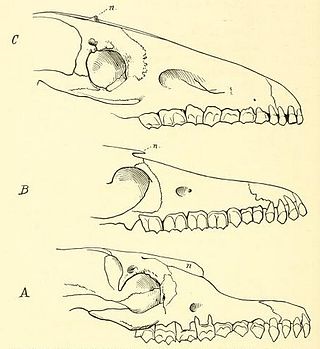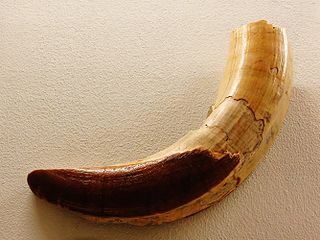Related Research Articles

Florentino Ameghino was an Argentine naturalist, paleontologist, anthropologist and zoologist, whose fossil discoveries on the Argentine Pampas, especially on Patagonia, rank with those made in the western United States during the late 19th century. Along with his two brothers – Carlos and Juan – Florentino Ameghino was one of the most important founding figures in South American paleontology.

Scalabrinitherium is an extinct genus of mammals of the family Macraucheniidae. Fossils of this animal were found among the fossils of prehistoric xenarthrans in the Ituzaingó Formation of Argentina.
Henricosborniidae is a family of extinct notoungulate mammals known from the Late Paleocene to Middle Eocene of Argentina, Bolivia and Brazil. The name honors U.S. paleontologist Henry Fairfield Osborn.

Interatherium is an extinct genus of interatheriid notoungulate from the Early to Middle Miocene (Colhuehuapian-Mayoan). Fossils have been found in the Santa Cruz, Collón Curá and Sarmiento Formations in Argentina.

Patagornis is a genus of extinct flightless predatory birds of the family Phorusrhacidae. Known as "terror birds", these lived in what is now Argentina during the Early and Middle Miocene; the Santa Cruz Formation in Patagonia contains numerous specimens. Patagornis was an agile, medium sized Patagornithine and was likely a pursuit predator.

Veratalpa lugdunensiana is a fossil mammal from the Miocene of France. Known from a single astragalus, the species was assigned to its own genus, Veratalpa, by Florentino Ameghino in 1905. He placed it in Talpidae, the family of the moles, but in 1974, John Howard Hutchison argued that the astragalus was not talpid and more likely came from a rodent. The astragalus is about 4.5 mm long, broad for a talpid, and has the head oriented farther from the axis of the foot than in talpids.

Parastrapotherium is an extinct genus of South American land mammal that existed from the Late Oligocene to the Early Miocene. The genus includes some of the largest and smallest known astrapotherian, but at present no generally recognized description can adequately characterize it.
Promacrauchenia is an extinct genus of macraucheniids that lived during the Late Miocene to Late Pliocene epochs of what is now Argentina and Bolivia. It belongs to the subfamily Macraucheniinae, which also includes Huayqueriana, Macrauchenia, and Xenorhinotherium. Fossils of this genus have been found in the Ituzaingó, Andalhuala, and Cerro Azul Formations of Argentina.
Polymorphis is an extinct genus of litopterns belonging to the family Macraucheniidae. It lived during the Middle Eocene of Argentina.
Proectocion is an extinct genus of adianthid litoptern. It lived during the Early Eocene, in what is now South America.
Henricosbornia is an extinct genus of henricosborniid notoungulate that lived from the Late Paleocene to the Middle Eocene of what is now Argentina and Brazil.
Eohyrax is an extinct genus of Notoungulate, belonging to the suborder Typotheria. It lived during the Middle Eocene, and its remains were discovered in South America.

Trachytherus is an extinct genus of mesotheriid notoungulate that lived from the Late Oligocene to the Early Miocene in what is now South America.

Pseudotypotherium is an extinct genus of Notoungulates, belonging to the suborder Typotheria. It lived from the Late Miocene to the Late Pliocene, and its fossilized remains were discovered in South America.

Isotemnus is an extinct genus of notoungulate belonging to the family Isotemnidae. It lived from the Late Paleocene to the Middle Eocene of what is now Argentina.
Colpodon is an extinct genus of herbivorous mammal, belonging to the order Notoungulata. It lived during the Early Miocene, in what is today Argentina and Chile, in South America.
Archaeopithecus is an extinct genus of notoungulate, belonging to the suborder Typotheria. It lived during the Middle Eocene, in what is today Argentina.
Hapaloides is an extinct genus of ground sloth of the family Megalonychidae, endemic to Argentina during the Early Miocene. It lived from 21.0 mya to 17.5 mya, existing for approximately 3.5 million years.
Liarthrus is a genus of astrapotheriid mammal known from the Late Oligocene Sarmiento Formation of Santa Cruz Province, Argentina. It was described by the Argentine paleontologist Florentino Ameghino in 1895 along with several other genera from the "Pyrotherium Beds", which were then believed to date to the Cretaceous period. Ameghino described Liarthus on the basis of fragmentary, being only a right astragalus, premolar 4, and an incomplete premolar from the upper jaws. Only one species was described, L. copei, the species name honoring the American paleontologist Edward Drinker Cope, who lived during the same interval as Ameghino. Liarthrus was synonymized with the other astrapothere Parastrapotherium in 1914 by American mammologist Frederic Loomis, though it was revalidated by a 2008 analysis of Parastrapotherium. Liarthrus was a herbivorous mammal, being an astrapothere, which had large tusks on their skulls and mandibles in addition to a large body size.
Orthoarthrus is an extinct species of mammal of unknown affinities that lived in Argentina during the Miocene. It was described by prolific Argentine paleontologist Florentino Ameghino in 1904 on the basis of a single left astragalus that had been unearthed from the Santacrucian sediments of Santa Cruz, Argentina. Ameghino described it as a species of pangolin closely related to African species of the group, but this came into question by 20th century paleontologists who concluded that it was an indeterminate genus of mammal. The size of the astragalus and its anatomy was described briefly, with a diameter of 30 millimetres (1.2 in) and a distinct furrowed morphology on its ventral face. The species name mixtus ("mixed") is after the anatomy of the astragalus' rugged bottom surface.
References
- ↑ "Fossilworks: Argyromanis patagonica". www.fossilworks.org. Retrieved 2023-06-11.
- ↑ Ameghino, Florentino (1904). "Nuevas especies de mamíferos, cretáceos y terciarios de la República Argentina". Anales de la Sociedad Cientifica Argentina. 56–58: 1–142.
- ↑ Sharpe, D. (Ed.). (1912). Index Zoologicus No. II.: An Alphabetical List of Names of Genera and Subgenera Proposed for Use in Zoology as Recorded in the" Zoological Record," Vols. 38-47 Inclusive (1901-1910) and the Zoology Volumes of the" International Catalogue of Scientific Literature" Annual Issues 1-10, Together with Other Names Not Included in Previous Nomenclators (No. 2). Society.
- ↑ Mones, A. (1986). Palaeovertebrata Sudamericana.-Catálogo Sistemático de los Vertebrados Fósiles de America-del Sur-Parte I. Lista Preliminar y Bibliografía.
- ↑ Vizcaíno, S. F., & Bargo, M. S. (2014). Loss of ancient diversity of xenarthrans and the value of protecting extant armadillos, sloths and anteaters. Edentata, 15(2014), 27-38.